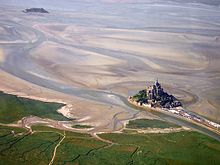Mont-Saint-Michel Bay
| UNESCO World Heritage Site | |
|---|---|
 | |
| Criteria | Cultural: i, iii, vi |
| Reference | 80 |
| Inscription | 1979 (3rd Session) |
| Coordinates | 48°38′05″N 1°30′38″W / 48.634722°N 1.510556°W |
The Mont Saint-Michel Bay is located between Brittany (to the south west) and the Normandy peninsula of Cotentin (to the south and east). The bay is part of the club of the world's most beautiful bays (fr) and is listed as a UNESCO world heritage site. Due to the significant tidal movements in this region (over 10 meters) a large part of the bay is uncovered at low tide. There are two granitic islands in the bay: Tombelaine and the Mont Saint-Michel. Many birds and harbor seal live in this area.
General considerations

The mont Saint-Michel bay is about 500 km2 (190 sq mi) in size.
Adjacent towns and villages
The following towns and villages surround the bay, from north to south:
- In Normandy : Carolles, Champeaux, Saint-Jean-le-Thomas, Dragey-Ronthon, Genêts, Vains, Marcey-les-Grèves, Avranches, Le Val-Saint-Père, Céaux, Courtils, Huisnes-sur-Mer, Pontorson, Le Mont-Saint-Michel, Beauvoir.
- In Brittany : Saint-Georges-de-Gréhaigne, Roz-sur-Couesnon, Saint-Broladre, Cherrueix, Mont-Dol, Le Vivier-sur-Mer, Hirel, Saint-Benoît-des-Ondes, Saint-Méloir-des-Ondes and Cancale.
Geography
Rivers
Three small rivers end in the bay (and cross it at low tide): the Couesnon, now blocked to the west of the mont Saint-Michel by a causeway, the Sée and the Sélune. The very low slope of the bay and the very large tides formed a mascaret in those rivers that can travel upstream for many kilometers.
Three larger rivers end in the bay: the Sélune, the Sée and mainly the Couesnon that, accordingly to some local folk stories, was originally the boundary between Normandy and Brittany but then moved to the West of the Mont placing it in Normandy. In reality the boundary is not at the river location but 4 kilometers further to the West, at the foot of Mont Saint-Broladre.
Biggest tides in Europe
The biggest tides in Europe occur in the mont Saint-Michel bay: with an average 10 meter amplitude, they reach 12 meters in average and up to 16 meters during the highest tides. This is due in part to the low depth of the bay and the barrier effect from the Cotentin Peninsula.[1]
The ocean moves very fast, both at low and at high tide, up to 10 kilometers away. The tides have been described by Victor Hugo as "à la vitesse d'un cheval au galop" or "as swiftly as a galloping horse". In reality the full extent of the tides is only visible at the entry of the bay (the sea level around the mont Saint-Michel is above the low tide level) and its actual speed is closer to a walking human, the fastest observed being around 6.1 km/h.[2]
The tides mix the water, creating a rich local ecosystem. The intertidal zone, the coastal area affected by the tides is about 200 km2 wide.
During the highest tide, a Tidal bore can be observed. Less so since the bay has been under restoration work.[1]
Levee and polders

The levee
polders have been developed in the Mont Saint-Michel bay from the 8th century or earlier than that. Between "pointe de Château-Richeux" and Mont Saint-Broladre seashell deposits have been used to create levees around Dol marsh. To the East of Sainte-Anne chapel is the "Duchesse-Anne" levee. It is 20 km long. It was built during the 11th century using granite rocks. It marks the South border of the polders.
In 1856, M. Mosselman, founder of the "Cie des Polders de l'Ouest", was given a concession to cultivate 3800 hectares of shoreline between Sainte-Anne chapel, Moidrey bay, Roche-Torin and the Mont Saint Michel.
